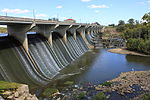Olentangy Indian Caverns
Caves of OhioDelaware, OhioLandforms of Delaware County, OhioShow caves in the United StatesTourist attractions in Delaware County, Ohio
The Olentangy Indian Caverns are a series of caves, natural passages and rooms occupying three different levels. The caverns were formed millions of years ago by an underground river that cut through the limestone rock. They were used by the Wyandotte Indians as a refuge from the weather and from their enemies the Delaware Indians. Artifacts found in the caverns indicate that it was used by the Wyandotte as late as 1810. The Olentangy Indian Caverns are located at 1779 Home Road, Delaware, Ohio and are open seasonally for tours.
Excerpt from the Wikipedia article Olentangy Indian Caverns (License: CC BY-SA 3.0, Authors).Olentangy Indian Caverns
Home Road, Liberty Township
Geographical coordinates (GPS) Address Nearby Places Show on map
Geographical coordinates (GPS)
| Latitude | Longitude |
|---|---|
| N 40.192153 ° | E -83.062308 ° |
Address
Olentangy Indian Caverns
Home Road
43015 Liberty Township
Ohio, United States
Open on Google Maps







